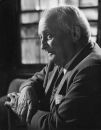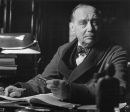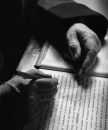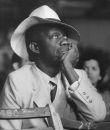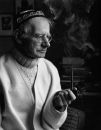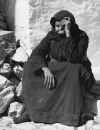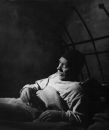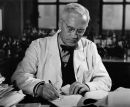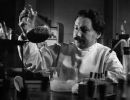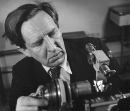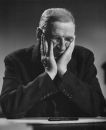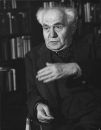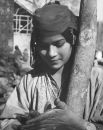Talking Hands
Although portraits could also end at the sitter’s chin, in Suschitzky’s photographs, they must include the hands. It is the hands that carry out chores, support the head while thinking, hold a pipe or pen, apply henna or underline what is being said with a gesture – the hands are an essential part of what constitutes someone’s personality.
Several of these photographs bear significance for Suschitzky well beyond the moment, such as the portrait of O’Casey, whom he met during an interview for NBC in 1955, from which a close lifelong friendship developed between the photographer and the dramatist and his family; or the study of Alfie Bass in The Bespoke Overcoat, Jack Clayton’s directorial debut, which was to win the Oscar for Best Short Film in 1955.
“Suschitzky’s approach is almost abstract. Instead of documenting poverty, the spare curve-like appearance of the metal bedsteads implies it without going into time-consuming detail. Note that lighting is expressionistic, rather than harshly revealing, without emotion.” (Martin S. Dworkin)
Likewise, the portrait p. 55 of a woman suffering from leprosy, who held up the part of her body for Suschitzky that used to be a hand, also had a lasting effect. “A charity asked me to work on a film about leprosy in Tamil Nadu, South India. It was for an appeal to support research and treatment of sufferers. Richard Bigham was director, and his wife Joanna was organiser. On our return LEPRA used this picture for an appeal in the press. It collected about £250,000. That was quite a lot of money in those days.”
Several of these photographs bear significance for Suschitzky well beyond the moment, such as the portrait of O’Casey, whom he met during an interview for NBC in 1955, from which a close lifelong friendship developed between the photographer and the dramatist and his family; or the study of Alfie Bass in The Bespoke Overcoat, Jack Clayton’s directorial debut, which was to win the Oscar for Best Short Film in 1955.
“Suschitzky’s approach is almost abstract. Instead of documenting poverty, the spare curve-like appearance of the metal bedsteads implies it without going into time-consuming detail. Note that lighting is expressionistic, rather than harshly revealing, without emotion.” (Martin S. Dworkin)
Likewise, the portrait p. 55 of a woman suffering from leprosy, who held up the part of her body for Suschitzky that used to be a hand, also had a lasting effect. “A charity asked me to work on a film about leprosy in Tamil Nadu, South India. It was for an appeal to support research and treatment of sufferers. Richard Bigham was director, and his wife Joanna was organiser. On our return LEPRA used this picture for an appeal in the press. It collected about £250,000. That was quite a lot of money in those days.”

